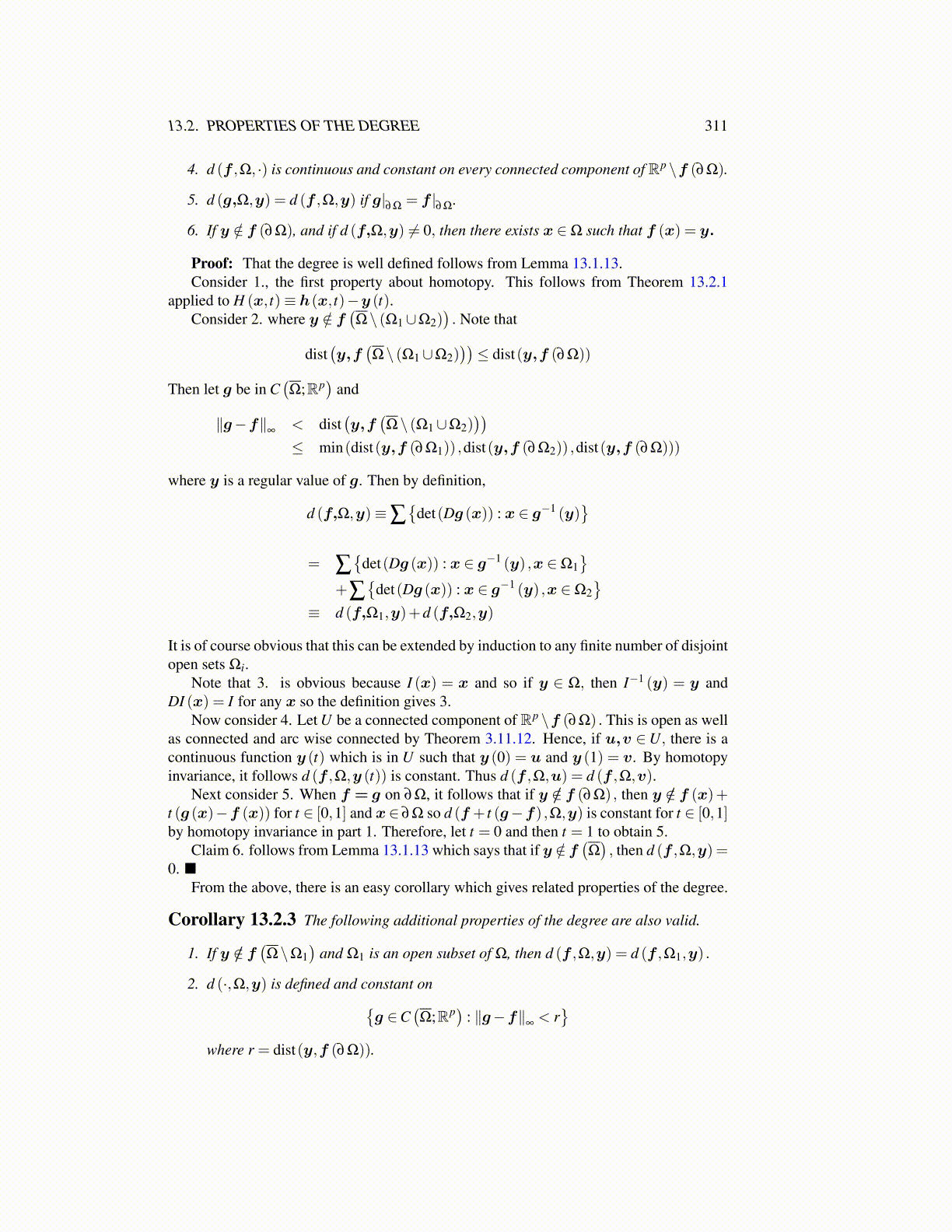
13.2. PROPERTIES OF THE DEGREE 311
4. d (f ,Ω, ·) is continuous and constant on every connected component of Rp \f (∂Ω).
5. d (g,Ω,y) = d (f ,Ω,y) if g|∂Ω
= f |∂Ω
.
6. If y /∈ f (∂Ω), and if d (f,Ω,y) ̸= 0, then there exists x ∈Ω such that f (x) = y.
Proof: That the degree is well defined follows from Lemma 13.1.13.Consider 1., the first property about homotopy. This follows from Theorem 13.2.1
applied to H (x, t)≡ h(x, t)−y (t).Consider 2. where y /∈ f
(Ω\ (Ω1∪Ω2)
). Note that
dist(y,f
(Ω\ (Ω1∪Ω2)
))≤ dist(y,f (∂Ω))
Then let g be in C(Ω;Rp
)and
∥g−f∥∞
< dist(y,f
(Ω\ (Ω1∪Ω2)
))≤ min(dist(y,f (∂Ω1)) ,dist(y,f (∂Ω2)) ,dist(y,f (∂Ω)))
where y is a regular value of g. Then by definition,
d (f,Ω,y)≡∑{
det(Dg (x)) : x ∈ g−1 (y)}
= ∑{
det(Dg (x)) : x ∈ g−1 (y) ,x ∈Ω1}
+∑{
det(Dg (x)) : x ∈ g−1 (y) ,x ∈Ω2}
≡ d (f,Ω1,y)+d (f,Ω2,y)
It is of course obvious that this can be extended by induction to any finite number of disjointopen sets Ωi.
Note that 3. is obvious because I (x) = x and so if y ∈ Ω, then I−1 (y) = y andDI (x) = I for any x so the definition gives 3.
Now consider 4. Let U be a connected component of Rp \f (∂Ω) . This is open as wellas connected and arc wise connected by Theorem 3.11.12. Hence, if u,v ∈U, there is acontinuous function y (t) which is in U such that y (0) = u and y (1) = v. By homotopyinvariance, it follows d (f ,Ω,y (t)) is constant. Thus d (f ,Ω,u) = d (f ,Ω,v).
Next consider 5. When f = g on ∂Ω, it follows that if y /∈ f (∂Ω) , then y /∈ f (x)+t (g (x)−f (x)) for t ∈ [0,1] and x∈ ∂Ω so d (f + t (g−f) ,Ω,y) is constant for t ∈ [0,1]by homotopy invariance in part 1. Therefore, let t = 0 and then t = 1 to obtain 5.
Claim 6. follows from Lemma 13.1.13 which says that if y /∈ f(Ω), then d (f ,Ω,y) =
0. ■From the above, there is an easy corollary which gives related properties of the degree.
Corollary 13.2.3 The following additional properties of the degree are also valid.
1. If y /∈ f(Ω\Ω1
)and Ω1 is an open subset of Ω, then d (f ,Ω,y) = d (f ,Ω1,y) .
2. d (·,Ω,y) is defined and constant on{g ∈C
(Ω;Rp) : ∥g−f∥
∞< r}
where r = dist(y,f (∂Ω)).